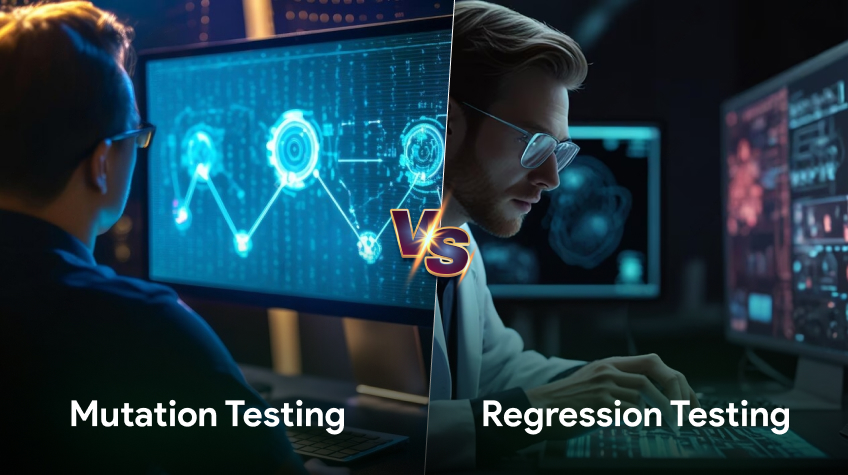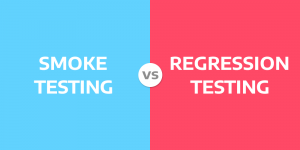
Software testing is one of the most important steps in software development. Proper testing verifies and validates the software quality. There are numerous kinds of software testing methods available out there. However, the most popular ones include Mutation testing and regression testing. These two testing methods ensure that the software meets the customer’s requirements or expectations.
Both testing methodologies differ greatly, and it is crucial for testers to know the key difference between them. So, if you also want to learn the differences between Mutation Testing vs Regression Testing and know which is better, then read this post. In this post, we shall discuss everything you need to know about these two popular testing methodologies. Let’s get started…
First off, let’s begin with the basics of these two testing methods. Here we go…
Table of Contents
- What Is Mutation Testing?
- What Is Regression Testing?
- Mutation Testing vs Regression Testing
- Mutation Testing vs Regression Testing: When to Choose Which Testing
What Is Mutation Testing?
Mutation testing, also known as a software testing method, is part of White Box Testing. In this method, testers change the source code and then test it. Testers aim to assess the quality and efficiency of the software test suite using this methodology. It is considered the best method when it comes to examining whether or not the test suite can detect the changed source code. This method aids testers or engineers in identifying errors or bugs in the early development stage of the software. Then, fixing up vulnerabilities in the system becomes easier and affordable. This is considered a vital part of the software developmental cycle.
With the help of mutation testing, the developer ensures that the software functions according to the determined roles. Moreover, this can integrate into a larger system without defects or flaws. In short, the whole procedure is time-consuming and expensive.
Also Read: Advantages and Disadvantages of Mutation Testing in Software Testing?
What Is Regression Testing?
Regression testing is yet another form of software testing that is conducted after the software is delivered to the customer. The main aim of this testing method is to verify that software functions as it intends to after modifications, updates, revisions, or optimizations. This ensures there is no error in the software due to the previous changes and newly added functionalities. This type of testing is majorly considered a part of the system maintenance activity.
There are two ways to conduct regression testing, i.e., manual and automated. Testers can choose to opt for any kind of testing method (manual or automated) depending on the size or comprehensiveness of the software. This plays a crucial role in upgrading the software. These upgrades are undertaken to make any software more robust, resilient, and secure. This method does not see any logic in checking the whole system, which makes it a cost-friendly and less time-consuming software testing method.
Let’s now take a look at the major differences between the two most popular software testing methods. Here we go…
Mutation Testing vs Regression Testing
Here are some of the most common differences between Mutation Testing and Regression Testing. Check out the following table to learn them in detail. Take a look…
| Mutation Testing | Regression Testing | |
|---|---|---|
| Definition | Mutation testing tests software at the development stage. It specifically focuses on making changes to test suits to ensure that the test suite can efficiently detect errors in the source code. | Regression testing is done after the software is delivered to the client. This test focuses on detecting new updates implemented to the application to ensure they do not cause any defects in the system. |
| Purpose | The main purpose of this software testing is to catch up on errors or bugs in the software and fix them in a timely fashion. | This testing intends to assess the functionalities of the software or identify the bug after the upgrade. |
| Which Type of Test | It is a part of white-box testing | It is a part of black-box testing |
| When to conduct | Mutation Testing is conducted during the development phase | Regression Testing is conducted after delivering the software to the customer (especially after a new feature is added to the system or if the software is updated) |
| Test Environment | Performed in a production environment as the software is not fully developed | Generally performed in a controlled environment |
| Test Coverage | It is less comprehensive as it covers the specific inputs and outputs | It is a comprehensive method as it covers all the functionalities of the application to examine its efficacy |
| Resources Required | It is more resource-intensive as it tests the old test cases. It needs the assistance of more manpower and extra servers | It is based on external resources such as databases and web servers |
| Test Mode | It can fully be automated with AI | It can be both manual or automated |
| Tools and Techniques | PITest, Mutpy, Jester, Symflower, Insure++, etc. | Testsigma, Subject7, Cerebrus, Selenium WebDriver, etc. |
| Time Taken | Mutation Testing can be more time-consuming as it generates a large number of test suites | Regression Testing is less time-consuming as it focuses on only the upgraded part of the application or software. |
| Cost | Expensive | Affordable |
Mutation Testing vs Regression Testing: When to Choose Which Testing
Both Mutation Testing and Regression Testing are crucial parts of the software development lifecycle (SDLC). Beginners often find them identical due to the modifications involved in it. However, it is crucial for them to know the key differences so that they can use them both in an effective manner. Both these testing methods are vital to fixing bugs or errors and improving the software quality; however, the procedure for conducting these tests is not similar.
Mutation test coverage is small as it focuses on individual components’ quality functioning and performance. On the contrary, the coverage area of the regression test is wide as it ensures that the modifications or updates to the software do not deteriorate the application’s overall functionality. So, whenever you need to choose the testing methods, keep in mind their procedures and the time when these two should be used.
Always remember that the software undergoes mutation testing to fix bugs and issues throughout the development cycle. This methodology assists developers in improving the test suite quality. On the other hand, regression testing is conducted before introducing a new version of the application to customers. This ensures that new functionalities or modifications do not negatively influence the software. All in all, both the testing methods are crucial, just their time of usage differ.
The Bottom Line
So, these are the major differences between Mutation Testing and Regression Testing. Hopefully, this article has successfully explained the differences between Mutation Testing vs. Regression Testing. In mutation testing, the focus is on analyzing the effectiveness of the software test suite. On the contrary, the regression technique emphasizes examining the functionality of the modified application.
The purpose of both testing is to provide customers with error-free and bug-free software. However, when it comes to their processes, there are a great deal of differences that set them apart from one another. Both the methods of testing software are crucial. None of these testing methods can in any way take the place of another testing.
Happy Software Testing… 😊 😊






